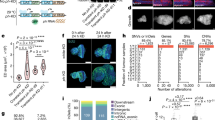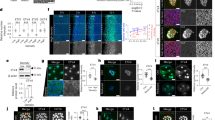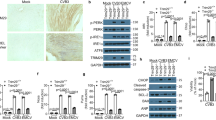Abstract
Cell motility is essential for viral dissemination1. Vaccinia virus (VACV), a close relative of smallpox virus, is thought to exploit cell motility as a means to enhance the spread of infection1. A single viral protein, F11L, contributes to this by blocking RhoA signalling to facilitate cell retraction2. However, F11L alone is not sufficient for VACV-induced cell motility, indicating that additional viral factors must be involved. Here, we show that the VACV epidermal growth factor homologue, VGF, promotes infected cell motility and the spread of viral infection. We found that VGF secreted from early infected cells is cleaved by ADAM10, after which it acts largely in a paracrine manner to direct cell motility at the leading edge of infection. Real-time tracking of cells infected in the presence of EGFR, MAPK, FAK and ADAM10 inhibitors or with VGF-deleted and F11-deleted viruses revealed defects in radial velocity and directional migration efficiency, leading to impaired cell-to-cell spread of infection. Furthermore, intravital imaging showed that virus spread and lesion formation are attenuated in the absence of VGF. Our results demonstrate how poxviruses hijack epidermal growth factor receptor-induced cell motility to promote rapid and efficient spread of infection in vitro and in vivo.
This is a preview of subscription content, access via your institution
Access options
Access Nature and 54 other Nature Portfolio journals
Get Nature+, our best-value online-access subscription
$29.99 / 30 days
cancel any time
Subscribe to this journal
Receive 12 digital issues and online access to articles
$119.00 per year
only $9.92 per issue
Buy this article
- Purchase on Springer Link
- Instant access to full article PDF
Prices may be subject to local taxes which are calculated during checkout




Similar content being viewed by others
Data availability
All data and reagents will be made available upon reasonable request.
References
Sanderson, C. M., Way, M. & Smith, G. L. Virus-induced cell motility. J. Virol. 72, 1235–1243 (1998).
Valderrama, F., Cordeiro, J. V., Schleich, S., Frischknecht, F. & Way, M. Vaccinia virus-induced cell motility requires F11L-mediated inhibition of RhoA signaling. Science 311, 377–381 (2006).
Ridley, A. J. Rho GTPase signalling in cell migration. Curr. Opin. Cell Biol. 36, 103–112 (2015).
Friedl, P. & Wolf, K. Tumour-cell invasion and migration: diversity and escape mechanisms. Nat. Rev. Cancer 3, 362–374 (2003).
Reig, G., Pulgar, E. & Concha, M. L. Cell migration: from tissue culture to embryos. Development 141, 1999–2013 (2014).
Cheng, F. et al. KSHV-initiated notch activation leads to membrane-type-1 matrix metalloproteinase-dependent lymphatic endothelial-to-mesenchymal transition. Cell Host Microbe 10, 577–590 (2011).
Abaitua, F., Zia, F. R., Hollinshead, M. & O’Hare, P. Polarized cell migration during cell-to-cell transmission of herpes simplex virus in human skin keratinocytes. J. Virol. 87, 7921–7932 (2013).
Dawson, C. W., Laverick, L., Morris, M. A., Tramoutanis, G. & Young, L. S. Epstein–Barr virus-encoded LMP1 regulates epithelial cell motility and invasion via the ERK–MAPK pathway. J. Virol. 82, 3654–3664 (2008).
Kivi, N., Greco, D., Auvinen, P. & Auvinen, E. Genes involved in cell adhesion, cell motility and mitogenic signaling are altered due to HPV 16 E5 protein expression. Oncogene 27, 2532–2541 (2008).
Irwin, C. R. & Evans, D. H. Modulation of the myxoma virus plaque phenotype by vaccinia virus protein F11. J. Virol. 86, 7167–7179 (2012).
Cordeiro, J. V. et al. F11-mediated inhibition of RhoA signalling enhances the spread of vaccinia virus in vitro and in vivo in an intranasal mouse model of infection. PLoS ONE 4, e8506 (2009).
Handa, Y., Durkin, C. H., Dodding, M. P. & Way, M. Vaccinia virus F11 promotes viral spread by acting as a PDZ-containing scaffolding protein to bind myosin-9A and inhibit RhoA signaling. Cell Host Microbe 14, 51–62 (2013).
McFadden, G. & Moyer, R. in Cytokine Reference (eds Oppenheim, J. J. & Feldmann, M.) 841–846 (Academic Press, San Diego, 2000).
Chang, W., Lim, J. G., Hellstrom, I. & Gentry, L. E. Characterization of vaccinia virus growth factor biosynthetic pathway with an antipeptide antiserum. J. Virol. 62, 1080–1083 (1988).
King, C. S., Cooper, J. A., Moss, B. & Twardzik, D. R. Vaccinia virus growth factor stimulates tyrosine protein kinase activity of A431 cell epidermal growth factor receptors. Mol. Cell. Biol. 6, 332–336 (1986).
Twardzik, D. R., Brown, J. P., Ranchalis, J. E., Todaro, G. J. & Moss, B. Vaccinia virus-infected cells release a novel polypeptide functionally related to transforming and epidermal growth factors. Proc. Natl Acad. Sci. USA 82, 5300–5304 (1985).
Stroobant, P. et al. Purification and characterization of vaccinia virus growth factor. Cell 42, 383–393 (1985).
Buller, R. M., Chakrabarti, S., Cooper, J. A., Twardzik, D. R. & Moss, B. Deletion of the vaccinia virus growth factor gene reduces virus virulence. J. Virol. 62, 866–874 (1988).
Lai, A. C. & Pogo, B. G. Attenuated deletion mutants of vaccinia virus lacking the vaccinia growth factor are defective in replication in vivo. Microb. Pathog. 6, 219–226 (1989).
Buller, R. M., Chakrabarti, S., Moss, B. & Fredrickson, T. Cell proliferative response to vaccinia virus is mediated by VGF. Virology 164, 182–192 (1988).
Hickman, H. D. et al. Direct priming of antiviral CD8+ T cells in the peripheral interfollicular region of lymph nodes. Nat. Immunol. 9, 155–165 (2008).
Bidgood, S. R. & Mercer, J. Cloak and dagger: alternative immune evasion and modulation strategies of poxviruses. Viruses 7, 4800–4825 (2015).
Postigo, A., Martin, M. C., Dodding, M. P. & Way, M. Vaccinia-induced epidermal growth factor receptor–MEK signalling and the anti-apoptotic protein F1L synergize to suppress cell death during infection. Cell. Microbiol. 11, 1208–1218 (2009).
Andrade, A. A. et al. The vaccinia virus-stimulated mitogen-activated protein kinase (MAPK) pathway is required for virus multiplication. Biochem. J. 381, 437–446 (2004).
Tzahar, E. et al. Pathogenic poxviruses reveal viral strategies to exploit the ErbB signaling network. EMBO J. 17, 5948–5963 (1998).
Kim, H. S. et al. Tyrosine phosphorylation of phospholipase C-γ1 by vaccinia virus growth factor. Virology 214, 21–28 (1995).
Bonjardim, C. A. Viral exploitation of the MEK/ERK pathway—a tale of vaccinia virus and other viruses. Virology 507, 267–275 (2017).
Huang, C., Jacobson, K. & Schaller, M. D. MAP kinases and cell migration. J. Cell Sci. 117, 4619–4628 (2004).
Langhammer, S., Koban, R., Yue, C. & Ellerbrok, H. Inhibition of poxvirus spreading by the anti-tumor drug gefitinib (Iressa). Antiviral Res. 89, 64–70 (2011).
Schweneker, M. et al. The vaccinia virus O1 protein is required for sustained activation of extracellular signal-regulated kinase 1/2 and promotes viral virulence. J. Virol. 86, 2323–2336 (2012).
Singh, A. B. & Harris, R. C. Autocrine, paracrine and juxtacrine signaling by EGFR ligands. Cell. Signal. 17, 1183–1193 (2005).
Blobel, C. P. ADAMs: key components in EGFR signalling and development. Nat. Rev. Mol. Cell Biol. 6, 32–43 (2005).
Ludwig, A. et al. Metalloproteinase inhibitors for the disintegrin-like metalloproteinases ADAM10 and ADAM17 that differentially block constitutive and phorbol ester-inducible shedding of cell surface molecules. Comb. Chem. High Throughput Screen. 8, 161–171 (2005).
Cudmore, S., Cossart, P., Griffiths, G. & Way, M. Actin-based motility of vaccinia virus. Nature 378, 636–638 (1995).
Doceul, V., Hollinshead, M., van der Linden, L. & Smith, G. L. Repulsion of superinfecting virions: a mechanism for rapid virus spread. Science 327, 873–876 (2010).
Yakimovich, A. et al. Infection: a generic framework for computational simulation of virus transmission between cells. mSphere 1, e00078-15 (2016).
Yang, M. & Huang, C. Z. Mitogen-activated protein kinase signaling pathway and invasion and metastasis of gastric cancer. World J. Gastroenterol. 21, 11673–11679 (2015).
Payne, L. G. Significance of extracellular enveloped virus in the in vitro and in vivo dissemination of vaccinia. J. Gen. Virol. 50, 89–100 (1980).
Yang, H. et al. Antiviral chemotherapy facilitates control of poxvirus infections through inhibition of cellular signal transduction. J. Clin. Invest. 115, 379–387 (2005).
Aldaz-Carroll, L. et al. Epitope-mapping studies define two major neutralization sites on the vaccinia virus extracellular enveloped virus glycoprotein B5R. J. Virol. 79, 6260–6271 (2005).
Mercer, J. & Helenius, A. Vaccinia virus uses macropinocytosis and apoptotic mimicry to enter host cells. Science 320, 531–535 (2008).
Tinevez, J. Y. et al. TrackMate: an open and extensible platform for single-particle tracking. Methods 115, 80–90 (2017).
Yakimovich, A. et al. Plaque2.0—a high-throughput analysis framework to score virus–cell transmission and clonal cell expansion. PLoS ONE 10, e0138760 (2015).
Breiman, L. Random forests. Mach. Learn. 45, 5–32 (2001).
Arganda-Carreras, I. et al. Trainable Weka Segmentation: a machine learning tool for microscopy pixel classification. Bioinformatics 33, 2424–2426 (2017).
Efron, B. Bootstrap methods: another look at the jackknife. Ann. Stat. 7, 1–26 (1979).
Ferreira, N., Klosowski, J. T., Scheidegger, C. E. & Silva, C. T. Vector field k-means: clustering trajectories by fitting multiple vector fields. Comput. Graph. Forum 32, 201–210 (2013).
Cush, S. S. et al. Locally produced IL-10 limits cutaneous vaccinia virus spread. PLoS Pathog. 12, e1005493 (2016).
Pieri, L., Sassoli, C., Romagnoli, P. & Domenici, L. Use of periodate-lysine-paraformaldehyde for the fixation of multiple antigens in human skin biopsies. Eur. J. Histochem. 46, 365–375 (2002).
Acknowledgements
We thank K. Gonciarz and I. F. Sbalzarini for helpful discussions. We thank B. Siegenthaler and J. Crouse for initial work on the project. We thank all members of the Mercer lab for helpful discussions and comments on the manuscript. We thank A. Vaughan, V. Jäggin, T. Lopes, T. Lummen, T. Horn and D. Loeffler for technical support. We thank B. Moss (NIAID) for the vSC20 virus. This research was supported by core funding to the MRC Laboratory for Molecular Cell Biology, University College London (MC_UU12018/7) (J.M.), the European Research Council (649101–UbiProPox) (J.M.), ETH Zurich (G.F. and D.J.M.) and the Division of Intramural Research of the NIAID (G.V.R. and H.D.H.). C.B. is funded by the MRC Laboratory for Molecular Cell Biology PhD programme.
Author information
Authors and Affiliations
Contributions
C.B., S.K. and J.M. conceived the project. C.B., A.Y., S.K. and J.M. designed the experiments. G.V.R. and H.D.H. designed, performed and analysed the intravital imaging. G.F. and D.J.M. designed and performed the cell sorting and single-cell imaging. C.B., A.Y. and J.M. analysed the data. C.B., A.Y., H.D.H., G.F. and J.M. wrote the manuscript. All authors discussed the experiments, read and approved the manuscript.
Corresponding author
Ethics declarations
Competing interests
The authors declare no competing interests.
Additional information
Publisher’s note: Springer Nature remains neutral with regard to jurisdictional claims in published maps and institutional affiliations.
Supplementary information
Supplementary Information
Supplementary Figures 1–5, Supplementary Table 1.
Supplementary Video 1
VACV WR and mutant plaque formation.
Supplementary Video 2
VACV plaque formation in the presence of EGFR, MEK or FAK inhibitors.
Supplementary Video 3
VACV plaque formation adjacent to wounds.
Supplementary Video 4
VACV plaque formation in the presence of ADAM10 inhibitor.
Rights and permissions
About this article
Cite this article
Beerli, C., Yakimovich, A., Kilcher, S. et al. Vaccinia virus hijacks EGFR signalling to enhance virus spread through rapid and directed infected cell motility. Nat Microbiol 4, 216–225 (2019). https://doi.org/10.1038/s41564-018-0288-2
Received:
Accepted:
Published:
Issue Date:
DOI: https://doi.org/10.1038/s41564-018-0288-2
This article is cited by
-
Mpox (formerly monkeypox): pathogenesis, prevention, and treatment
Signal Transduction and Targeted Therapy (2023)
-
A systems biology approach for investigating significantly expressed genes among COVID-19, hepatocellular carcinoma, and chronic hepatitis B
Egyptian Journal of Medical Human Genetics (2022)
-
Genome-wide CRISPR screen for HSV-1 host factors reveals PAPSS1 contributes to heparan sulfate synthesis
Communications Biology (2022)
-
Influenza- and MCMV-induced memory CD8 T cells control respiratory vaccinia virus infection despite residence in distinct anatomical niches
Mucosal Immunology (2021)
-
H-Ras gene takes part to the host immune response to COVID-19
Cell Death Discovery (2021)



